Specifications:
Mass: ca. 113 g with mounting bracket and cable.
Size: width: ca. ?? mm, height: ca ?? mm, length ca. ?? mm.
LED: ?
On/off: On/automatic. In automatic mode DRL is always on during the daytime
Price: € 140,-
| [ Main index » Bicycle components tests » (Dynamo) bicycle lighting » Headlamps with cutoff for dynamo » B&M IQ X | ] |
Tested: From 21 Feb 2016
Update: 2024-1-7: Experiences with an IQ-X in Ukraine where I used it for 1000 km.
Specifications:
Mass: ca. 113 g with mounting bracket and cable. Pictures: |
First ride shows a weaker first part of the beam, then after 10m or so a stronger one. The second one is very wide at say 30-40 m distance (and more). The cutoff is sharp. The lux rating is only slightly more than the Herrmans H-one S (which is 95 lux) though the IQ-X puts out more light and it gives more reach (I mentioned that lux rating is not enough to guarantee throw elsewhere on my site). Further, it is a quite wide beam, perhaps not quite like the Edelux2 but I'd need to check. In any event, the Edelux 2 (and thus also Cyo premium) has a very poor beam which is very dark with hotspots, absolutely not useful for illuminating meandering roads, and I will check to see how well this works with the IQ-X. The IQ-X, as usual with most bike lamps, overexposes near the bike, and on the front wheel. The 2 parts of the beam are distracting in some situations, and often riding on the narrowish road 3 I felt something was not right, as if the lamp was pointed sideways. I think this is caused by too much light close to the rider next to this narrow road, but I will do more proper testing when this fooking stormy weather ceases! It is clear however that this lamp does not have the beam quality of the Saferide 80 (yes, a battery lamp, but such a lamp can be run off of a dynamo as I've shown). More on this after a direct comparison, soon.
2016-2-23: This night I rode a long distance riding again on road 3 (narrow reddish asphalt, and after that other roads, much wider roads, and meandering roads... I compared it on those roads to the saferide 80 (neutral white) though its batteries were almost empty, which I noticed too late, so I did not have enough time to compare the IQ-X with the Saferide 80 on full power. Next time more comparing to be sure. The impressions of asymmetry from the first ride were confirmed, and then I found out why this feeling is so strong with this lamp (B&M really need someone who is critical to ride with their lamp designs who notices things like this!) It is caused by the clear distinction of the 2 beams. The strongest beam starts at about 8-10 m from the lamp, the weaker beam starts on top of the front wheel. There is a intersection where at the edge you see a pattern which indicates this difference. What happens on the road with a dyke on one side (and the road is not quite horizontal too) is that you see the projection on the dyke, and the horizontal line on the road goes crooked. This gives the feeling that the lamp is mounted at an angle on the bike... This feeling absolutely does not happen with other lamps that I've ridden with, this is the first one... It doesn't happen at all with the Saferide 80 as I confirmed during this ride.
Wide beams are mainly of use for meandering or winding roads, and I tested this and found the IQ-X not really working except to see that there is a bend in the road coming, from larger distance. The beam is really wide, ca. 15 m at 50-60m distance, more than the Saferide 80 which is ca. 10m wide there, but it only works to see that a bend in the road is coming. While you are following the bend, you are going blind into it (you don't see the edge of the road on the right for a bend that goes to the right)... I suggested a way around this already during the Philips bike lighting day in January 2012... I had been thinking during this ride about what would be needed further, and when a motorist overtook me this night, I watched his beam carefully. Very different from bike lamps, wide from the start, which is likely what is needed... (but I have a different beamshape design in mind, more on that another time).
I had thought long ago already about the problem of near-projection on hedges and walls of light meant for long distance, and I had noticed this effect with a few headlamps ca. 2014 but in those lamps the problem was not big. I realised that it could become a real problem, and the IQ-X is where this is the case. Really, B&M need to get someone to do some proper testing/analysing!
Here are beamshots during riding, so not proper crisp beamshots yet, but from this you can see some of the problems that I mentioned if you analyse them and read my descriptions about the problems in the IQ-X's beam:
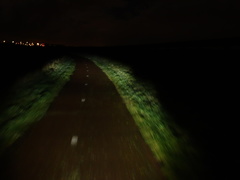
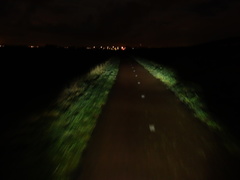
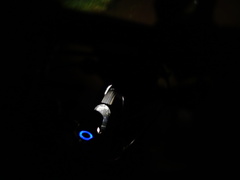
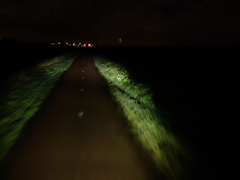
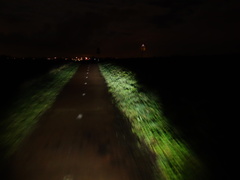
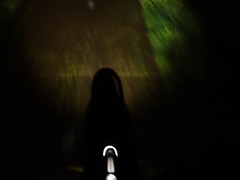
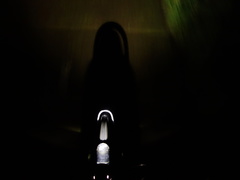
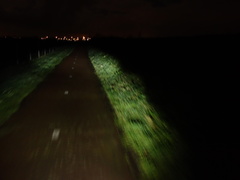
2016-3-4: This night I tested the IQ-X vs. Roxim D6, Trelock LS906, Saferide 80 neutral white. Again the issues with the beam of the IQ-X are clear, and there are various causes. I will explain a bit more.
The Roxim D6' beam has 2 downsides: The beam starts too far from the bike, and the light next to you is distracting, it can even give the impression of another cyclist coming to overtake you. The same happens with the hotspot on the left with the Edelux II/Cyo Premium. But the beam of the D6 is on the whole very pleasant to ride with (unlike the very dark and uneven Edelux II), and it is cheap. I checked during cornering whether the beamshape is useful to see the road close to you, as Roxim claims. Well, it's not and it's almost useless during cornering just like the IQ-X. Reach is about 50m (which was better than all other dynamo lamps I had tested before the D6, only the IQ-X and LS905/906 are now better in this respect), but far less than the IQ-X which has a reach close to that of the Saferide 80, and less wide at long distances. But this doesn't mean the IQ-X is much better. The distractions from the wrong beamshape which gives issues when riding on uneven terrain and the artefacts, mean that with the IQ-X I'm not just riding, I'm always wondering what the hell is wrong with the lamp!
The Trelock LS906 has a very strong beam, and has none of the issues of the IQ-X but in beam it's similar to a LS885, in being not that even, but compared to the LS885 it is brighter, wider and with far more reach. I think reach is about the same as the IQ-X and the Saferide 80, up to 70 m. This means being able to see, distinguish 'something small and white' on the road, such as road markings that can be identified at that distance. More is about impossible, not just because of amount of light needed, but because you can't very well make out anything small at longer distances. And so the LS906 seems to me in reality just as good as the IQ-X in use. The IQ-X has a far nicer housing and technically more intricate optics (I talked in 2013 already with Charlie Tsai about using e.g. lenses to first bundle the LED's light, then to a reflector, and something like this is going on with the IQ-X) but that's not important in use!
The Saferide 80 is neutral white so comparing with the cool white beams of the LS906 and IQ-X is hard as cool white gives the impression of being brighter. But switching beams while riding it became clear that with the Saferide 80 I could see better at the 50-70m range than with the IQ-X and LS906. Also the beam of the Saferide 80 is unequalled in how even it is. You have weird artefacts close to you, but, not distracting or giving weird experiences. The IQ-X has a far sharper cutoff which is good and that is really needed for proper aiming. Switching between Saferide 80 and IQ-X/LS906 the beams of the latter are clearly of a bad light colour. Why do they still persist in using this bad choice? The Roxim D6 is also better than the IQ-X/LS906 in this respect.
My current impressions:
2016-3-15: This night I ran with the Renak experimental hub which is lower power and that was useful as it showed me the beam at lower power. At higher power, various details get washed out, but they are still there just less noticable, i.e. they don't jump out. And from the low power running I found that the optic is not quite symmetrical indeed. This is an issue with 2 light sources. From the optic's shape I think it is a TIR that then creates 2 smaller light sources. If you have 2 or more light sources you need to take care of how well they match, something I've also thought about and will tell a bit more about perhaps at a later date on what my solution to that potential issue is.
Silva Trail elite head-mounted 600 lm lamp: Every time I use it at home or in the garden I'm amazed at how much light comes out of the tiny head, of course battery is external, but still it's an amazing lamp, but only for short distances. On the bike I could not see far with it, and here in NL normally it's barely usable because the non-cutoff light means you get almost blinded by all the retro-reflective traffic signs... I tested the Trail elite on a meandering bit of road, where the D6 and IQ-X completely fail to light up the road as you would need light close to you and wide to the left/right, and here the head mounted lamp that you can point with your head, ahead of actual turning, works well. I think this lamp is used a lot by runners at night, and for that I suppose it's useful (in the right areas). For cycling too, on meandering roads, you could use it, but not as the only lamp, as throw is not far enough. The beam is very wide and even, and that doesn't work for throw, you need some part that is concentrated, and so I felt I could only see a fairly short distance with it, about 30m or so (I will check on another ride, to make sure, it wasn't my priority this ride to measure throw, I was really only checking for how well it works with bends in the road).
For public roads, in Germany it is illegal (from StVO's rule of not allowing a searchlight) and in NL it would be too from the general rule of not blinding other traffic simply because you put out too much light in all directions. Note by the way, that on this topic, as some people claim that as StVZO only deals with bicycles, this means that in Germany you are allowed to use any lighting on your clothes/body: This is not the case. I mentioned long ago elsewhere already, that not everything needs to be spelled out in laws to be clear that something is not allowed! In an 'explanation' in the StVZO text, this is actually made clear, namely StVZO §67 explanation 13: "Rückstrahlende Mittel u Leuchtstoffe an Fußgängern u Radfahrern". This says that a blinking red light mounted on a cyclist, is NOT allowed (because blinking-red light is used to signify other matters on the road, e.g. train crossings). It does say that blinking orange light is allowed... There are more obvious examples that I can think of, such as as a white to-be-seen lamp on the rear on your clothes, or a red lamp on your front, which would of course not be acceptable.
This is a laugh. They say to aim the light cone (the beam) onto the road at 10 m distance. This is the same type of bullshit as in StVZO. I mentioned on my StVZO page that there is no definition of middle of the beam in the StVZO text (but StVZO does use this term to say how to aim a bicycle headlamp!), and that is correct, but I recently did find somewhat of a definition of 'middle of the beam' but only in StVZO.§29.explanation.37. §29 is about investigating motorised vehicles and their trailers, not bicycles, but still... They use that definition for high beams and for "Dauerabblendlicht" for farm vehicles (and here it seems to mean DRL, though normally Abblendlicht = beam with cutoff, but in this section they seem to use it in the general sense of 'not-blinding'). They do not use 'middle of the beam' for proper cutoff light! The definition is very brief and really incomplete, and certainly not applicable to a real cutoff beam. To aim the middle of beam (which is actually a pointless concept for a beam with cutoff as I explained on my StVZO page) or the end of the beam, anywhere in the region of 10m distance, is just inane. Nobody in his right mind will aim this lamp at 10m when it can light up the road more than 60m far! And this is what B&M actually do, contrary to the BS in their manual, with the beamshot picture on the back of the packaging: The cutoff is aimed to at least 50m and no way in hell with whatever interpretation (see my StVZO page) you give to StVZO's bogus aiming requirement, is it aimed at anything near 10 m! The only proper prescription is to aim the lamp such that nothing goes above the horizon and really you need to aim the highest intensity at about 60m (better less). Such distances are already problematic for poor roads, where at every little bump in the road opposing traffic gets hit with a blinding flash of light.
For background information on making beamshots see: Camera settings, lamp settings and roads used to make the beamshots.
Proper beamshots of the IQ-X to be made soon along with the Trelock LS906.
B&M IQ X |
|
|
Lamp height 0.75m Camera: h=1.65, d=-0.40, aim=50m
(Original 20 megapixel) |
|
The pattern in the light beam near the front wheel:

(Original 20 megapixel)
The IQ-X along with Trelock's LS905/906 put out the most amount of light I've ever seen from factory made dynamo lamps with cutoff. The IQ-X has a beautiful housing. I don't like DRL but thankfully B&M have put a diffuser in front of the DRL LEDs. The beam has a very sharp cutoff which is good to aim it properly and to not blind oncoming traffic, but the beam is too wide at long distance which is not useful and has a downside, as it gives the feeling of a lopsided beam when riding on uneven ground or along hedges or banks. Close to the front wheel it has bad artefacts (strong straight line esp.) and overexposure. The first 10m or so the beam is very uneven. It puts out so much light, that it must be similar to the Saferide 80 (battery powered, 270 lumen, which is still the reference headlamp for anything running from battery or dynamo), but in usefulness it is not better than the Saferide 80 (no stronger illumination, the beam is more uneven, the wider beam at long distance is not useful) and in riding experience it doesn't come close to the Saferide 80's beam at all (because of the uneven beam compared to the Saferide 80, with the Saferide 80 each ride is relaxed, with the IQ-X not). I ride a lot on fairly narrow roads/bicycle paths, often 3-5m wide and if you ride on wider roads then perhaps you will not get annoyed in the same way? But for me, the IQ-X's beam annoys me each ride... But as it gives so much light it's hard not to recommend the IQ-X, or the LS905/906. You must choose whether the artefacts and other issues might be a problem for you, then decide. I'm still undecided: Perhaps I will choose the LS906 over the IQ-X for my daily use bike (I will ride more with the LS906 to decide). Perhaps I will even go back to the D6...
Update: I have gone back to using the Roxim D6 sometime in 2016. The only alternative for me would be the Saferide 60 neutral white but at the moment I will keep using the D6. I didn't get round to making beamshots and I gave it to a friend, but perhaps I will make a video in early 2017 (make that 2018! :)), to compare a bunch of headlamps, switching between them while bicycling.
I bought a 2nd hand Stevens P18 with Pinion P1.18 gearbox in August 2023 in Chernivtsi (Ukraine). This bike came standard with the IQ-X. I rode about 1000 km with this bike, of which quite a bit was in the dark too as I often came to my destination at 20-23 o'clock in the evening... This was on mostly bad roads, some asphalt, a lot of gravel roads (with fairly big rocks, up to fist size), dirt roads with mostly sand and stones, etc. These trips really tested all my equipment! I had a lot of problems, first of all a bolt on the rear kickstand broke. It turned out this was a 5mm bolt with nut, whereas it should have been a 6mm bolt with locknut... Then came an issue with the panniers, 1 of them tore at a seam and I temporarily fixed that with 50mm wide tape.
The final issue was that the headlamp suddenly wasn't aimed properly any more and here we come to the IQ-X: I stopped. I thought that I may need to fix the bolt but it then turned out that the mount itself was broken. This is the ring around the lamp that also provides the sideways lighting. It is glued to the lamp. Perhaps this is why the lamp has a pattern that is not straight, i.e. with lines from the patterns not left-right symmetrical, namely if this ring is being glued slightly offset that would give such an issue. I may check this out later when making beamshots with this lamp without using that mount and then trying to aim it perfectly. This mounting ring is available as a spare part but I'm not that interested in getting it back to original state. This ring is made from very hard and thus brittle plastic, which is why it didn't survive 1000km on the bad roads. This is a mistake by B&M, along with the annoying beam pattern with artefacts in it. I felt the same about the IQ-X as when I first tested it, this lamp annoyed me on every ride. I used a Lumintop B01 (battery powered) on this bike too, which is not suitable to see at a long distance, so I used them in combination: The B01 for more and better close up light, the IQ-X to see far ahead.
The artefacts in the beam pattern were an annoyance in the Netherlands, in Ukraine on all the dirt roads, farm roads, gravel roads etc., it meant I really couldn't properly make out where to ride and this was alleviated somewhat by using the Lumintop B01 at the same time. An issue with using both at the same time was the different beam colours, with the Lumintop using neutral white light and the IQ-X cool white light.
2024-1-23: Let me add this emphasis on the beam homogeneity (after some moronic comments on youtube with my video comparing the Supernova M99 dynamo, Philips Saferide 80, Lumintop B01, Roxim D6 (dynamo): this is NOT about esthetics. Homogeneity of the beam is necessary when riding on bad roads to be able to properly select where to ride to evade bad sections such as potholes! The beam of the IQ-X was barely usable for this purpose in Ukraine on the all the various bad roads. I was often cursing at the IQ-X for being so bad, which means I had the ride even more slowly than I otherwise would have ridden (which was already slow because of the bad roads and not wanting everything to get shaken to bits!). The only good point of the IQ-X on this trip was the long range light and sharp cutoff. I used the beam of the IQ-X only on descents from hills where I could ride fast.
Once I have my stuff organised again I will make beamshots. Note that this may be middle of 2024, as almost everything I have is in storage now until I buy a house.
| To email me go to the email page |
2024-1-7